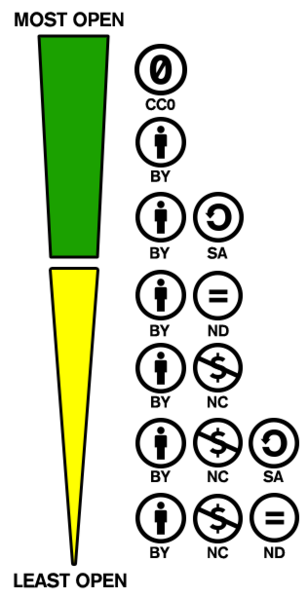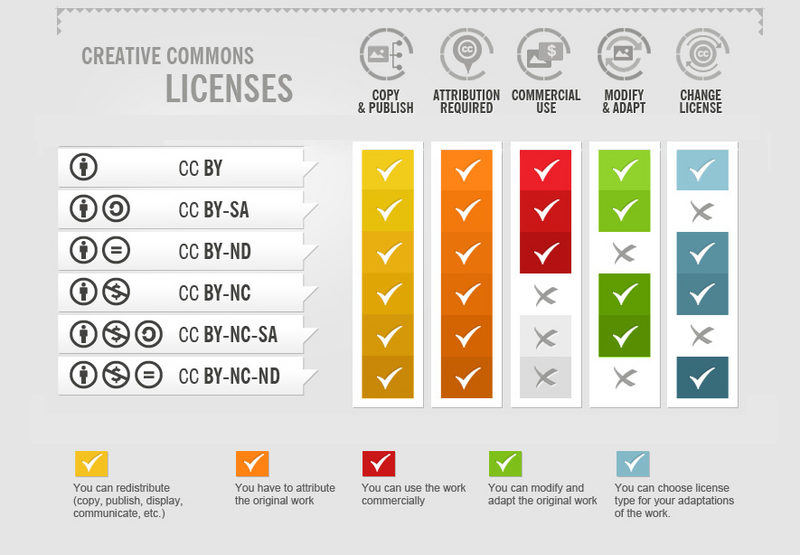About Open Licenses
What is an open license?
In most countries (including the United States), copyright is automatically applied to a work the moment it becomes fixed (e.g., written down, typed out, recorded, or drawn). Works not marked as being in copyright may still be copyrighted. People who want to reuse, redistribute, remix, or revise others’ content must ask for permission (except in some limited circumstances allowed under fair use).
If a creator wants people to be able to reuse their content without asking for permission every time, they can do this through a license. An open license, according to opendefinition.org, “is one which grants permission to access, re-use and redistribute a work with few or no restrictions.”
You do not need to become a copyright/licensing expert in order to use open educational resources in your course. A librarian can help answer questions you may have.
Why does it matter?
Open educational resources are course materials that are freely available and openly licensed so you can do the 5 R’s with the content: revise, remix, reuse, redistribute, and retain. You can download the material, tailor it to your course, save a copy locally, and share it publicly with attribution.
Types of open licenses
Creative Commons licenses are the most popular open licenses for open educational resources because they’re easy to create and understand. Other popular types of open licenses include open source licenses (common in programming) and open data licenses. The rest of this document provides more information about Creative Commons licenses.
Creative Commons License Conditions
Creative Commons provides six different licenses. These licenses are based on conditions that a creator can apply to future uses of their work. All six licenses require at least attribution (BY). The Creative Commons website offers explanations and examples of their licenses, and the options are also summarized below:
Attribution (BY)
You must give credit to the creator, but not in a way that suggests that they endorse your use.
ShareAlike (SA)
You can copy, distribute, display, perform, and modify the work, but you must distribute any modifications using the same conditions. You can still use and distribute the unaltered work without the SA condition (see this blog post from Molly Kleinman). For example, you could include an unedited CC BY-SA image in a slideshow that is distributed under another license.
NonCommercial (NC)
You can copy, distribute, display, perform, and (unless the creator has chosen No Derivatives) modify the work unless you’re doing so commercially. The Creative Commons FAQ states that commercial uses are those “primarily intended for or directed toward commercial advantage or monetary compensation.” The US Court of Appeals for the 2nd Circuit ruled that educators at nonprofit educational institutions may have copies printed, even when commercial entities make a profit on such transactions.
NoDerivatives (ND)
You can copy, distribute, display, perform, but not modify the work. If you want to modify such a work, you need to seek permission from the creator. Transferring a work from one format to another (from streaming video to DVD, for example) is not a modification (blog post from Molly Kleinman).
Public domain and CC0
A CC0 mark means the creator has waived all rights (even attribution) and dedicated the work to the public domain; there are no restrictions on how public domain works can be used. US federal government works and works whose copyright has expired are also in the public domain.
Infographics
This is what the six Creative Commons license icons look like:
![]() “Creative Commons” by
progressor is in the
Public Domain, CC0
“Creative Commons” by
progressor is in the
Public Domain, CC0

Ordering of Creative Commons licenses from most to least permissive by creativecommons.org is licensed under CC BY-SA 4.0
Chart showing which uses are permitted for each open license type:

“Creative Commons Licenses Infographic” by ricardo56 is licensed under CC BY-SA 2.0